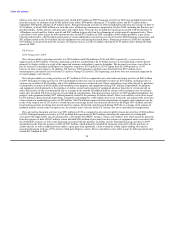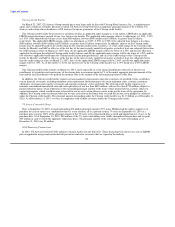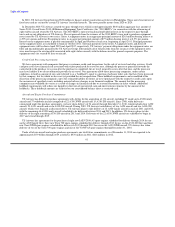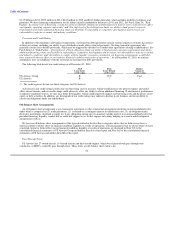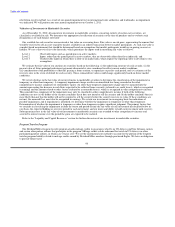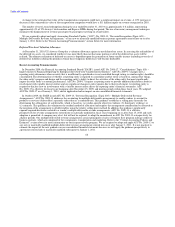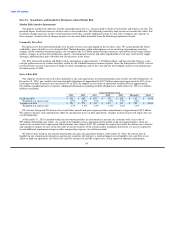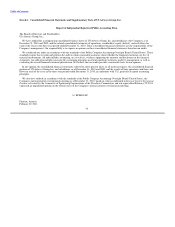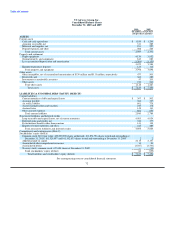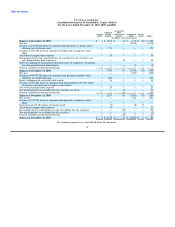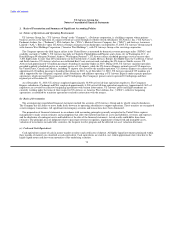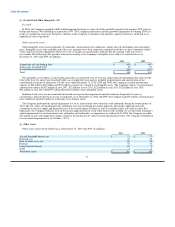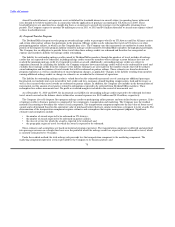US Airways 2010 Annual Report Download - page 69
Download and view the complete annual report
Please find page 69 of the 2010 US Airways annual report below. You can navigate through the pages in the report by either clicking on the pages listed below, or by using the keyword search tool below to find specific information within the annual report.
Table of Contents
A change to the estimated fair value of the transportation component could have a significant impact on revenue. A 10% increase or
decrease in the estimated fair value of the transportation component would have a $11 million impact on revenue recognized in 2010.
The number of travel award redemptions during the year ended December 31, 2010 was approximately 0.8 million, representing
approximately 4% of US Airways' total mainline and Express RPMs during that period. The use of inventory management techniques
minimizes the displacement of revenue passengers by passengers traveling on award tickets.
We are required to adopt and apply Accounting Standards Update ("ASU") No. 2009-13, "Revenue Recognition (Topic 605) –
Multiple-Deliverable Revenue Arrangements," to any new or materially modified business partner agreements entered into on or after
January 1, 2011. Refer to the "Recent Accounting Pronouncements" section below for more information.
Deferred Tax Asset Valuation Allowance
At December 31, 2010, US Airways Group has a valuation allowance against its net deferred tax assets. In assessing the realizability of
the deferred tax assets, we considered whether it was more likely than not that some portion or all of the deferred tax assets will be
realized. The ultimate realization of deferred tax assets is dependent upon the generation of future taxable income (including reversals of
deferred tax liabilities) during the periods in which those temporary differences will become deductible.
Recent Accounting Pronouncements
In December 2009, the Financial Accounting Standards Board ("FASB") issued ASU No. 2009-17, "Consolidations (Topic 810) –
Improvements to Financial Reporting by Enterprises Involved with Variable Interest Entities." ASU No. 2009-17 changes how a
reporting entity determines when an entity that is insufficiently capitalized or is not controlled through voting (or similar rights) should be
consolidated. The determination of whether a reporting entity is required to consolidate another entity is based on, among other things,
the other entity's purpose and design and the reporting entity's ability to direct the activities of the other entity that most significantly
impact the other entity's economic performance. ASU No. 2009-17 requires a reporting entity to provide additional disclosures about its
involvement with variable interest entities and any significant changes in risk exposure due to that involvement. A reporting entity is
required to disclose how its involvement with a variable interest entity affects the reporting entity's financial statements. ASU
No. 2009-17 is effective for fiscal years beginning after November 15, 2009, and interim periods within those fiscal years. We adopted
ASU No. 2009-17 as of January 1, 2010, and its application had no impact on our consolidated financial statements.
In October 2009, the FASB issued ASU No. 2009-13, "Revenue Recognition (Topic 605) – Multiple-Deliverable Revenue
Arrangements." ASU No. 2009-13 addresses the accounting for multiple-deliverable arrangements to enable vendors to account for
products or services (deliverables) separately rather than as a combined unit. This guidance establishes a selling price hierarchy for
determining the selling price of a deliverable, which is based on: (a) vendor-specific objective evidence; (b) third-party evidence; or
(c) estimates. This guidance also eliminates the residual method of allocation and requires that arrangement consideration be allocated at
the inception of the arrangement to all deliverables using the relative selling price method. In addition, this guidance significantly
expands required disclosures related to a vendor's multiple-deliverable revenue arrangements. ASU No. 2009-13 is effective
prospectively for revenue arrangements entered into or materially modified in fiscal years beginning on or after June 15, 2010 and early
adoption is permitted. A company may elect, but will not be required, to adopt the amendments in ASU No. 2009-13 retrospectively for
all prior periods. Our multiple-deliverable revenue arrangements consist principally of sales of frequent flyer program mileage credits to
business partners, which are comprised of two components, transportation and marketing. Refer to the "Critical Accounting Policies and
Estimates" section above for more information on our frequent traveler program. We are required to adopt and apply ASU No. 2009-13 to
any new or materially modified multiple-deliverable revenue arrangements entered into on or after January 1, 2011. It is not practical to
estimate the impact of the new guidance on our consolidated financial statements because we will apply the guidance prospectively to
agreements entered into or materially modified subsequent to January 1, 2011.
68


